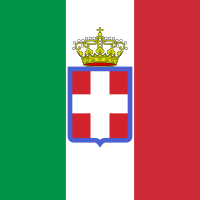
Back الجيش الملكي الإيطالي Arabic İtaliya Kral Ordusu Azerbaijani Regio Esercito Catalan Regio Esercito Spanish ارتش سلطنتی ایتالیا Persian Regio Esercito Finnish Armée royale (Italie) French הצבא המלכותי האיטלקי HE Regio Esercito Italian იტალიის სამეფო არმია Georgian
This article needs additional citations for verification. (July 2011) |
| Royal Italian Army | |
|---|---|
| Regio Esercito Italiano | |
 War Flag of the Regio Esercito | |
| Active | 1861–1946 |
| Country | |
| Allegiance | King of Italy |
| Type | Army |
| Size |
|
| Colors | Green, White and Red |
| Anniversaries | 4 November |
| Engagements | |
| Commanders | |
| Ceremonial chief | First Marshal of the Empire |
| Notable commanders | |
The Royal Italian Army (Italian: Regio Esercito, lit. 'Royal Army') (RE) was the land force of the Kingdom of Italy, established with the proclamation of the Kingdom of Italy. During the 19th century Italy started to unify into one country, and in 1861 Manfredo Fanti signed a decree creating the Army of the Two Sicilies. This newly created army's first task was to defend its territorial gains against Legitimists in southern Italy, who remained loyal to Francis II of the Two Sicilies. The Army of the Two Sicilies also waged what many modern historians now consider a civil war against outlaws and Bourbonist guerrillas, such as the famous Michelina Di Cesare, and against other Italian states' armies during the continuing wars of unification. After the monarchy ended in 1946, the army changed its name to become the modern Italian Army (Esercito Italiano).
Within the Italian Royal Army were the elite mountain military corporals, the Alpini. The Alpini, which remain in existence today, are the oldest active mountain infantry in the world. Their original mission was to protect and secure Italy's northern mountain border that aligns with France and Austria. This group emerged in World War I when a three-year campaign was fought against the Austro-Hungarian Kaiserjäger and the German Alpenkorps. In World War II, the Alpini fought alongside Axis forces in the Eastern Front as well as the Balkans Campaigns.[2]
- ^ Regio Esercito: The Italian Royal Army in Mussolini's Wars, 1935–1943, Patrick Cloutier, p. 211
- ^ "An Alpino in the Royal Italian Army". Library Trust Fund. 6 February 2018. Retrieved 20 April 2019.